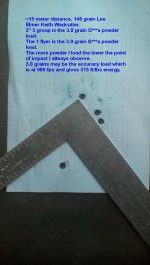TheGuyOfSouthamerica
Moderator
Today I shot again the 148 grain Lee Tumble Lube Wadcutter over the cronograph but this time with an different powder.
This time I used the O***a powder (scavenged from shotshell) which is the quickest burning I have as I believe.
First shot I used an 0.5 cc Lee powder dipper which I levelled off the powder and that gave exactly 3.6 grains. The Chrono APP did not work again but it gave me an velocity of 987 fps using 3.6 grain of the O***a powder with the deep seated 148 grain Lee TL Wadcutter.
That gives an energy of 320 ft/lbs.
With this powder load no particularly flattened primer nor sticky extraction was observed (primer was round on all edges).
Second reload was with an heaped full 0.5 cc Lee powder dipper (no levelling/scraping off powder) and that gave exactly 4.0 grain of powder. Same bullet as above that gives an energy of 351 ft/lbs.
This time the Caldwell APP worked and here is the result:
But any hotter I would not want to load this System (cartridge-gun System) since 351 ft/lbs is plenty of energy.
Observation: I have an Feeling as if the Lee Tumble Lube design works wonders in reducing the case pressure. I believe this quick burning load I would not want to risk with the Elmer Keith style Lee 148 grain Wadcutter. The TL design gives a slightly edge on velocity but I feel it does a great Job on reducing pressures of the cartridge and reducing recoil as well.
I wonder if the increase in velocity from 987 fps to 1034 fps is already an deminishing return for the 0.4 grain of powder increase (difference)!
This time I used the O***a powder (scavenged from shotshell) which is the quickest burning I have as I believe.
First shot I used an 0.5 cc Lee powder dipper which I levelled off the powder and that gave exactly 3.6 grains. The Chrono APP did not work again but it gave me an velocity of 987 fps using 3.6 grain of the O***a powder with the deep seated 148 grain Lee TL Wadcutter.
That gives an energy of 320 ft/lbs.
With this powder load no particularly flattened primer nor sticky extraction was observed (primer was round on all edges).
Second reload was with an heaped full 0.5 cc Lee powder dipper (no levelling/scraping off powder) and that gave exactly 4.0 grain of powder. Same bullet as above that gives an energy of 351 ft/lbs.
This time the Caldwell APP worked and here is the result:
The primer flattened this time but no particular sticky extraction could be observed (surprisingly no sticky extraction. Not more as with the Saga, Unique type powder at 4.0 grains). The primer is flat but not flatter as with the other loads and the case at extraction is only snug to the chamber and not approaching sticky extraction.Created: 14-02-2017 12:40:32 PM Description: 148 grain Lee Tumble Lube DE Wadcutter Notes 1: 4.0 grain scavenged powder brand O***a Notes 2: Pietta 357 mag SAA 5.5“ revolver Distance to Chrono (FT): 6.00 Ballistic Coefficient: 0.072 Bullet Weight (gr): 148.000 Altitude (FT): 400.0 Temp: N/A BP: N/A Shots # FPS FT-LBS PF 1 1034 351.41 153.03 Average: 0.00 StdDev: 0.00 Min: 1034 Max: 1034 Spread: 0 True MV: 0.00 Shots/sec: 0.00 Group Size (IN): 0.00
But any hotter I would not want to load this System (cartridge-gun System) since 351 ft/lbs is plenty of energy.
Observation: I have an Feeling as if the Lee Tumble Lube design works wonders in reducing the case pressure. I believe this quick burning load I would not want to risk with the Elmer Keith style Lee 148 grain Wadcutter. The TL design gives a slightly edge on velocity but I feel it does a great Job on reducing pressures of the cartridge and reducing recoil as well.
I wonder if the increase in velocity from 987 fps to 1034 fps is already an deminishing return for the 0.4 grain of powder increase (difference)!
Last edited:

